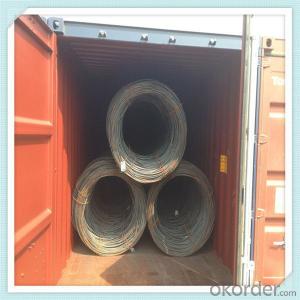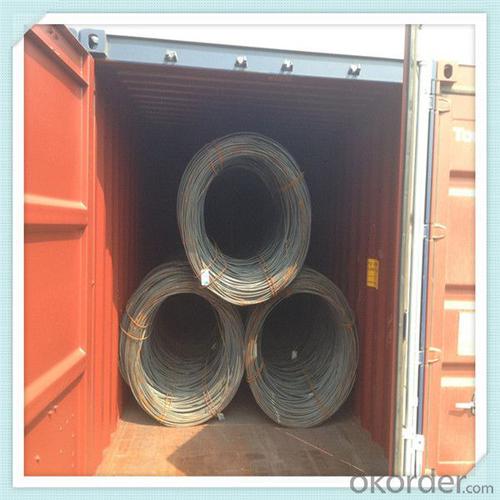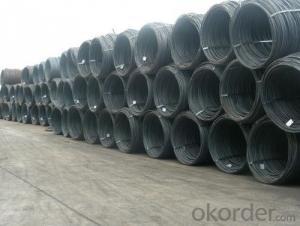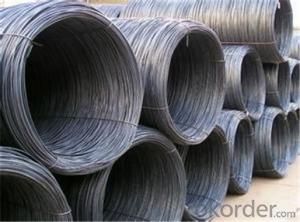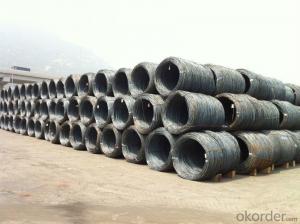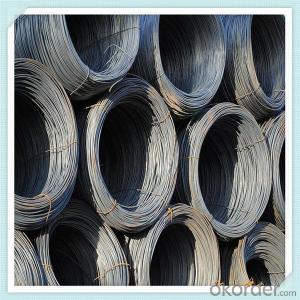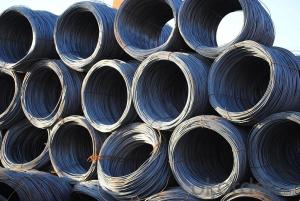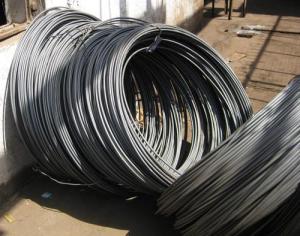SAE1006 Steel wire rod 5.5mm-14mm hot sale
- Loading Port:
- Tianjin
- Payment Terms:
- TT OR LC
- Min Order Qty:
- 100 m.t.
- Supply Capability:
- 13526 m.t./month
OKorder Service Pledge
OKorder Financial Service
You Might Also Like
Specification
Wire rod is a rolled alloy or nonalloy steel product, produced from a semi (e.g. bloom) and having a round,
rectangular or other cross-section. Particularly fine cross-sections may be achieved by subsequent cold
forming (drawing). Wire rod is wound into coils and transported in this form.
Features
1、Pure steel quality, stable chemical contents, small tolerance.
2、Constant Quality, good drawing performance.
3、High dimension accuracy degree, accuracy degree of Level C up to 80%, smooth surface, less scale,
easy to be pickled.
4、Automatic bundling with 4 lines by Machine in tidy and good looks
5、Big high quality percentage, small coil percentage, and heavy coil weight for Hard Coil.
6、High sorbitizing percentage.
Product Description :
Standard | AISI, ASTM, BS, DIN, GB, JIS |
Material/steel grade | Q195-Q235,SAE1006B,SAE1006CR, SAE1008B, SAE1008CR, SAE1010B, SAE1018B, or according to customers requirements |
Wire Gauge | 5.5-12mm |
Coil weight | 1.8-2.1mts |
MOQ | 25MT |
Delivery Time | 15-30 days after receipt of L/C or deposit by T/T |
Packing | In coil and load in container, if large quantity, by bulk vessel; Can be packed as customers' special requirements |
Payment terms | 1).100% irrevocable L/C at sight. 2).30% T/T prepaid and the balance against the copy of B/L. 3).30% T/T prepaid and the balance against L/C |
Application | widely used in machinery parts, manufacturing industry, electronics industry, metal tools and others |
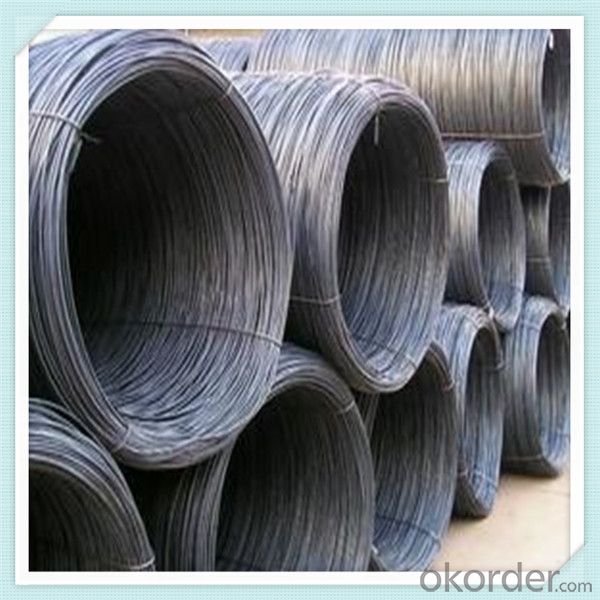
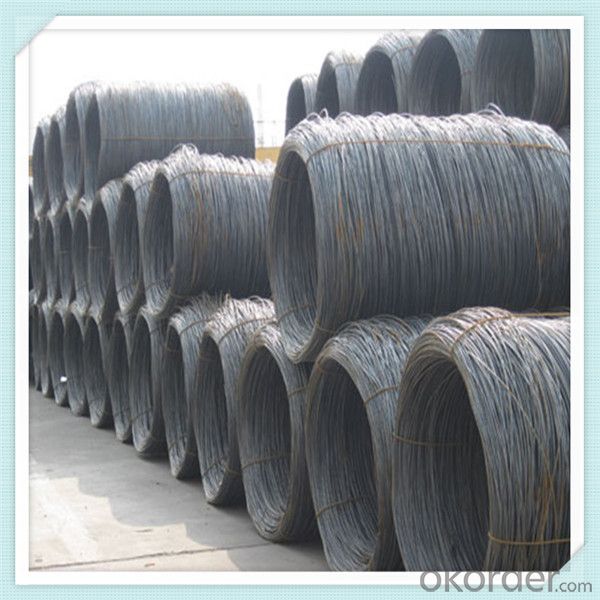
Application :
It generally used in braiding the hose for bathing product and machinery. With it
good flexibility, resistant to high temperature and resistant to corrosion, it
used widely in many industries.
Packing :
Hot-rolled wire rod is held in a unit with at least four steel straps in the
transverse direction and transported and stored without further packaging.
Before
the steel strapping is applied, the wire rod must be sufficiently compressed.
The strapping is fixed in the transverse direction with a single circumferential
strap so that the strapping does not slip and cause the coil to come apart.
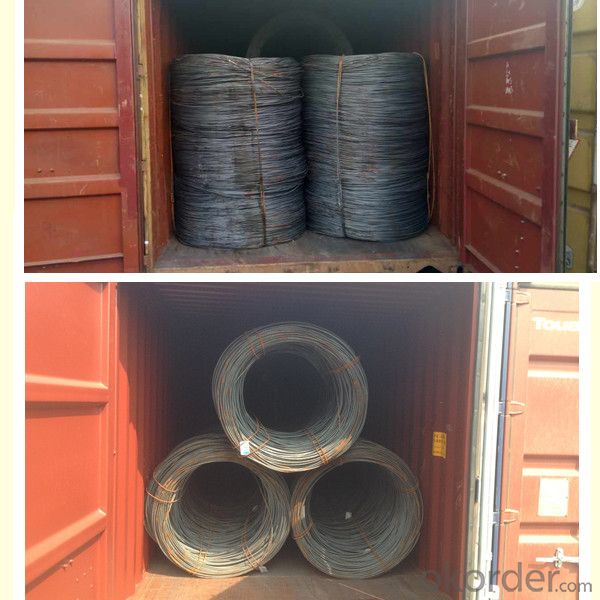
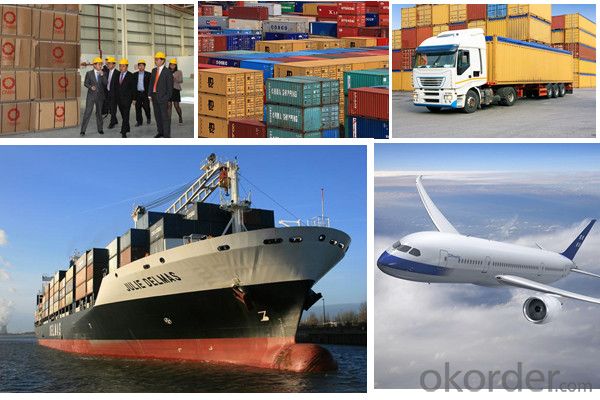
Our service:
(1) We cooperate with famous factories with advanced equipment and well trained workers.
(2) We can provide factory price with trading company service.
(3) We continuously work on the improvement of our processes, guaranteeing
consistently high standards of quality to keep none compensation.
(4) We guarantee 24 hours response and 48 hours solution providing service.
(5) We accept small order quantity before formal cooperation.
(6) We deliver the agreed quality at the agreed time, reacting to changes in
customer wishes in a flexible way.
(7) Due to our volume and selling power, we have excellent freight rates with
shipping lines.
(8) We strive to always be fair and honest in our dealings with customers.
(9) We strive to work together with customers to achieve much more than we can
achieve alone.
(10) Through our passion and commitment we aim to be a market leader in all our
key markets. To maintain our position as market leader we must continue to add
value in all that we do.
FAQ:
1.Q: What's your MOQ(minimum order quantity)?
A: One full container, mixed acceptable .
2. Q: What's your packing methods?
A: Packed in bundle or bulk ..
3. Q: How can I buy CNBM products in my country?
A:Please send us an inquiry or email ,we will reply to you if there is distributor in your country
4. Q: Can we visit your factory?
A: Warmly welcome. Once we have your schedule, we will arrange the
professional sales team to follow up your case.
5. Q: How long does it take to get the product if i place an order?
A:With the process of your requirements,we will pack and deliver in 3
-7 days. If it is by sea shipment,it will take 15-45 days depending on different locations
- Q: How does the magnetic properties of steel wire rod vary with different heat treatment processes?
- The magnetic properties of steel wire rod can vary significantly with different heat treatment processes. Heat treatment processes such as annealing, quenching, and tempering can influence the microstructure and crystallographic orientation of the steel, which in turn affects its magnetic properties. For example, annealing can result in the formation of a soft magnetic structure with improved magnetic permeability, while quenching and tempering can produce a harder magnetic structure with higher coercivity. Overall, the specific heat treatment process employed can determine the magnetic properties of steel wire rod, making it possible to tailor its magnetic characteristics for specific applications.
- Q: How is steel wire rod used in the manufacturing of wire forms for automotive exhaust systems?
- The manufacturing of wire forms for automotive exhaust systems heavily relies on steel wire rod. These wire forms are essential for providing structural support and stability to the exhaust system, ensuring its optimal functioning and long lifespan. To begin with, steel wire rod is employed to construct the primary framework of the wire form, which serves as the backbone of the exhaust system. This framework is responsible for securely holding and positioning various components of the exhaust system, including the muffler, catalytic converter, and pipes. The remarkable tensile strength and durability of steel wire rod make it an ideal choice for this purpose, as it can withstand the intense vibrations, heat, and pressure that the exhaust system encounters. Furthermore, steel wire rod is utilized to shape the hangers and brackets that fasten the exhaust system to the vehicle's chassis. These hangers and brackets are crucial for maintaining the correct alignment and stability of the exhaust system, preventing any unnecessary movement or rattling. The flexibility and malleability of steel wire rod enable it to be easily formed into the desired hanger or bracket design, ensuring a precise fit and dependable performance. Moreover, steel wire rod is also employed in the fabrication of wire mesh screens and filters that are installed within the exhaust system. These screens and filters play a vital role in trapping and eliminating contaminants, such as particulate matter and harmful gases, from the exhaust gases before they are released into the environment. The exceptional strength and corrosion resistance of steel wire rod make it an excellent choice for constructing these screens and filters, as they must endure harsh operating conditions and exposure to corrosive elements. In conclusion, steel wire rod plays a critical role in the manufacturing of wire forms for automotive exhaust systems. Its impressive tensile strength, durability, flexibility, and corrosion resistance make it the ideal material for constructing the main framework, hangers, brackets, and screens/filters within the exhaust system. By utilizing steel wire rod, manufacturers can ensure that the wire forms provide the necessary structural support, stability, and reliability required for the proper functioning of automotive exhaust systems.
- Q: What are the common applications of hot rolled steel wire rod?
- Hot rolled steel wire rod, being a versatile and strong material, finds numerous applications in various industries. Some of the most common applications of hot rolled steel wire rod include: 1. Construction: Hot rolled steel wire rod is extensively used in the construction industry for various purposes. It is commonly used in the production of concrete reinforcement bars (rebars) that provide strength and durability to buildings, bridges, and other infrastructure projects. Additionally, it is used for manufacturing fences, nails, and wire mesh, which are essential components in construction. 2. Automotive industry: Hot rolled steel wire rod is widely utilized in the automotive industry for the production of parts and components. It is used in the manufacturing of suspension systems, engine components, steering mechanisms, and various other automotive parts that require high strength and resilience. 3. Industrial machinery: Hot rolled steel wire rod is an essential material in the production of industrial machinery. It is used for manufacturing gears, shafts, bearings, and other components that require high strength, toughness, and resistance to wear and tear. 4. Wire products: Hot rolled steel wire rod is extensively used in the production of a wide range of wire products. It is used for manufacturing wire ropes, springs, cables, and other wire-based products that need to withstand heavy loads and provide reliability and durability. 5. Welding electrodes: Hot rolled steel wire rod is also used in the production of welding electrodes. These electrodes are used in various industries for welding and joining different types of metals. The high strength and ductility of hot rolled steel wire rod make it an ideal material for manufacturing welding electrodes. 6. Fasteners: Hot rolled steel wire rod is used for producing a variety of fasteners, such as bolts, screws, and nuts. These fasteners are widely used in industries like construction, automotive, and manufacturing, where strong and reliable connections are required. Overall, the common applications of hot rolled steel wire rod span across a wide range of industries, including construction, automotive, machinery, wire products, welding, and fasteners. Its strength, versatility, and durability make it an indispensable material in many manufacturing processes.
- Q: What are the different types of steel wire rod finishes for improved wear resistance?
- There are several types of steel wire rod finishes that can enhance wear resistance. Some of the common finishes include galvanized, zinc-coated, phosphate coated, and chrome-plated. These finishes provide an additional layer of protection to the steel wire rod, making it more resistant to wear and corrosion.
- Q: What are the different types of steel wire rod coatings used for increased ductility?
- To enhance ductility, various coatings are applied to steel wire rods. These coatings improve the wire rod's ability to deform without fracturing. Some commonly used coatings include: 1. Zinc Coating: Galvanizing, or zinc coating, is widely utilized. It forms a protective barrier between the steel and the surroundings, providing excellent corrosion resistance and enhancing ductility. 2. Phosphate Coating: Another popular option is phosphate coating. It creates a thin layer of phosphate crystals on the wire rod's surface. This layer promotes lubricity and reduces friction during the wire drawing process. 3. Copper Coating: Copper coating is often employed for highly ductile steel wire rods. It offers a lubricious surface, enabling easier deformation without the risk of cracking or fracturing. 4. Nickel Coating: Known for its exceptional resistance to corrosion and wear, nickel coating is also advantageous in enhancing ductility. It reduces friction during the wire drawing process, making it suitable for applications requiring high deformation capabilities. 5. Aluminum Coating: Aluminum coating increases the ductility of steel wire rods. Besides corrosion resistance, it enhances surface lubricity, resulting in smoother wire drawing operations. Each of these coatings possesses unique properties and benefits, making them suitable for different applications. The appropriate coating selection depends on factors such as intended use, environmental conditions, and desired level of ductility.
- Q: Can steel wire rod be used in high-temperature applications?
- When using steel wire rod in high-temperature settings, careful consideration must be given to the specific type of steel and the temperatures involved. Some steel grades, like stainless steel or heat-resistant alloys, are specifically designed to maintain strength and structural integrity under high temperatures. These types of steel are commonly used in industries such as aerospace, automotive, and power generation, where exposure to high temperatures is frequent. However, it is important to note that not all steel wire rods are suitable for high-temperature applications. Lower-grade steels may experience a reduction in mechanical properties, such as tensile strength, ductility, and corrosion resistance, when exposed to elevated temperatures. To determine if a particular steel wire rod is suitable for a high-temperature environment, it is essential to refer to the manufacturer's specifications or seek expert advice. In addition to the type of steel, other factors should be considered when using steel wire rod in high-temperature applications. These include the operating conditions, duration of exposure, and the presence of corrosive elements or chemicals. Regular monitoring and maintenance may be necessary to ensure the ongoing performance and safety of the steel wire rod in these environments.
- Q: How is steel wire rod tested for resistance to intergranular corrosion?
- Steel wire rod is typically tested for resistance to intergranular corrosion using the intergranular corrosion test method, such as the Strauss test or the Huey test. These tests involve subjecting the steel wire rod to specific conditions, such as exposure to an acidic solution or elevated temperature, to determine if it exhibits any signs of susceptibility to intergranular corrosion. The results of these tests provide valuable information about the material's resistance to this type of corrosion and help ensure its suitability for various applications.
- Q: What are the different heat treatment processes applied to steel wire rod?
- There are several heat treatment processes applied to steel wire rod, including annealing, quenching, tempering, and normalizing. Annealing involves heating the wire rod to a specific temperature and then slowly cooling it, which helps to reduce internal stress and improve its ductility. Quenching involves rapidly cooling the wire rod after heating it to a high temperature, which results in increased hardness and strength. Tempering is a process that follows quenching, in which the wire rod is reheated to a lower temperature to reduce brittleness and enhance toughness. Normalizing is a heat treatment process similar to annealing, but the cooling is done in still air, which helps to refine the grain structure and improve the mechanical properties of the wire rod.
- Q: How are steel wire rods used in the manufacturing of cables?
- Steel wire rods are an essential component in the manufacturing of cables. These rods serve as the core material for cable production and provide the necessary strength and durability required for various applications. To begin the cable manufacturing process, steel wire rods are carefully selected based on their quality and specific properties such as tensile strength, ductility, and corrosion resistance. These characteristics ensure that the final product will meet the desired standards and perform effectively in its intended application. Once the appropriate steel wire rods are chosen, they are subjected to various manufacturing processes such as drawing and stranding. Firstly, the rods are drawn through a series of dies to reduce their diameter and increase their length. This process, known as wire drawing, enhances the tensile strength and flexibility of the steel wire, ensuring it can withstand the stresses and strains that cables may encounter during their usage. Next, the drawn steel wires are stranded together to form the cable. Stranding involves intertwining multiple steel wires into a compact and uniform arrangement, creating a strong and flexible structure. The number of wires and their arrangement in the stranding process depend on the specific cable design and application requirements. Additionally, steel wire rods are often coated or treated with protective materials to enhance their performance. These coatings may include galvanization to prevent corrosion, lubricants to improve flexibility, or insulation materials to provide electrical insulation properties. These treatments further enhance the durability, longevity, and functionality of the cables. Overall, steel wire rods play a critical role in the manufacturing of cables by providing the necessary strength, flexibility, and durability required for reliable and efficient transmission of various signals, power, or data.
- Q: What are the different types of steel wire rod packaging options after wire drawing?
- After wire drawing, there are several packaging options available for steel wire rods. These options are designed to protect the wire rods during storage, transportation, and handling. The different types of steel wire rod packaging options include: 1. Coils: Steel wire rods can be packaged in the form of coils. The wire is wound around a cylindrical core, creating a compact and secure package. Coils are widely used for packaging steel wire rods, as they are easy to handle, stack, and transport. They are commonly available in different sizes, ranging from small coils for lightweight wire rods to larger coils for heavier gauge wire rods. 2. Spools: Spools are another popular packaging option for steel wire rods. The wire is wound around a spool, which provides a more organized and controlled arrangement. Spools are commonly used for smaller diameter wire rods, especially in industries where precision and ease of use are important, such as electrical and electronics industries. 3. Straight bars: In some cases, steel wire rods are packaged as straight bars. This packaging option is suitable for wire rods with larger diameters and lengths. Straight bars are often used in industries where the wire rods are further processed or cut into specific lengths for various applications. 4. Bundles: Steel wire rods can also be packaged in bundles. Bundles are created by tying together multiple wire rods using straps or wires. This packaging option is commonly used for longer wire rods that cannot be coiled or spooled. Bundles provide stability and protection to the wire rods during transportation and storage. 5. Pallets: Pallets are used to package wire rods in bulk quantities. The wire rods are stacked and secured on wooden or plastic pallets, ensuring easy handling and efficient storage. Pallets are commonly used for larger wire rod shipments, allowing forklifts or pallet jacks to move and transport the wire rods easily. 6. Containers: For international shipments or long-distance transportation, steel wire rods can be packaged in containers. Containers provide a secure and protected environment for wire rods, preventing damage from moisture, dust, or other external factors during transit. It is important to select the appropriate packaging option based on the size, weight, and specific requirements of the steel wire rods. Proper packaging ensures the integrity and quality of the wire rods, minimizing the risk of damage and facilitating efficient handling and transportation.
Send your message to us
SAE1006 Steel wire rod 5.5mm-14mm hot sale
- Loading Port:
- Tianjin
- Payment Terms:
- TT OR LC
- Min Order Qty:
- 100 m.t.
- Supply Capability:
- 13526 m.t./month
OKorder Service Pledge
OKorder Financial Service
Similar products
Hot products
Hot Searches
Related keywords
